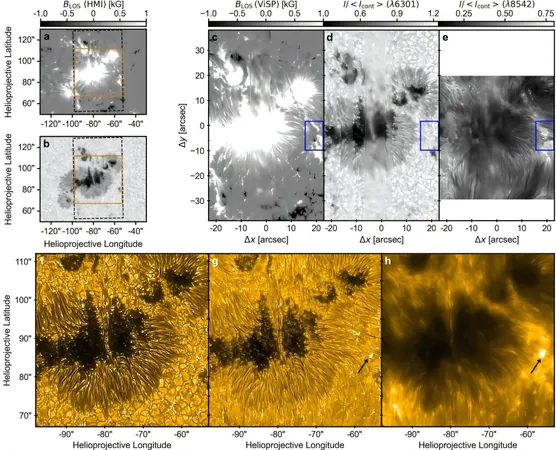
Unlocking the Sun: Groundbreaking Discoveries from Tiny Solar Explosions
2025-06-16
Author: Amelia
Small but Mighty: The Power of Microflares
In a stunning leap forward for solar research, scientists have utilized the world's most advanced solar telescope to capture extraordinary images of a microflare—small, yet incredibly powerful solar explosions. These insights are shedding light on the intricate magnetic fields that fuel the sun's smallest outbursts.
Research Breakthroughs from the Inouye Solar Telescope
Led by Dr. João da Silva Santos at the National Solar Observatory, this revolutionary study employed data from the NSF Daniel K. Inouye Solar Telescope in Maui to reveal how magnetic fields in the sun’s lower atmosphere can dramatically reconnect, releasing immense bursts of energy and plasma, a phenomenon termed magnetic reconnection. Just last month, their findings were published in The Astrophysical Journal.
Extraordinary Detail Revealed
Dr. da Silva Santos highlights, "This microflare offered a rare glimpse into a dynamic event where magnetic fields dramatically reconnected. We observed scorching plasma, rapid movements, and turbulent flows in a remarkably compact region measuring just 700 kilometers wide—unearthing substructures ten times smaller!" Despite its relatively minor size compared to larger solar flares, the energy unleashed was comparable to the power of 10 billion lightning strikes.
Unveiling Solar Mysteries
The flare, which transitioned from a simpler form resembling Ellerman bombs to a more complex microflare, was analyzed using advanced instruments like the Visible Broadband Imager (VBI) and the Visible Spectro-Polarimeter (ViSP). The telescope’s capabilities uncovered dazzling bursts of light, swift plasma flows, and intricate magnetic interactions high above the sun's surface.
The Mechanics of Magnetic Reconnection
The study revealed that brightening occurred in a densely packed area where opposing magnetic fields merged and cancelled each other out, releasing vast amounts of energy. Thanks to sophisticated spectropolarimetric analysis, researchers could map the temperature, velocity, and turbulence within the region, reconstructing the three-dimensional magnetic framework that governs these events.
A Collaborative effort that Fuels Future Research
Robert Jarolim, a scientist at the NSF National Center for Atmospheric Research (NSF NCAR) and co-author, explained, "The reconnection took place along a fan-spine magnetic structure, complete with a magnetic null point—an occurrence validated by our findings. This phenomenon was previously implied through simulations but now verified in detail.”
Empowering the Next Generation of Scientists
Undergraduate student Eric Dunnington from Rensselaer Polytechnic Institute significantly contributed to the research as a co-author. Participating in the NSF Research Experiences for Undergraduates program, he took part in data calibration and analysis, showcasing how undergraduate research can propel scientific advancement. "João provided me an incredible opportunity to present early findings at the AGU 2024 meeting in D.C.—a perfect example of the impact of collaborative scientific exploration!" he said.
Shattering the Mystique of Small-scale Reconnection
As the study zeroes in on small-scale reconnection phenomena in the sun's upper atmosphere, it addresses critical questions in solar physics. While larger solar flares have been extensively analyzed, these microflares remain elusive yet vital for understanding how the sun's energetic activities influence the space environment around Earth.
A New Era of Solar Observation
Dr. da Silva Santos concludes, "This research provides some of the strongest observational evidence yet that magnetic reconnection can occur in compact structures. Without the high resolution of the Inouye Telescope, these crucial details may have remained hidden forever." Thanks to the innovative technology of the NSF Inouye Solar Telescope, even the tiniest solar explosions will no longer remain mysteries—opening new frontiers in our quest to understand the sun's behavior and its effects on space weather.









 Brasil (PT)
Brasil (PT)
 Canada (EN)
Canada (EN)
 Chile (ES)
Chile (ES)
 Česko (CS)
Česko (CS)
 대한민국 (KO)
대한민국 (KO)
 España (ES)
España (ES)
 France (FR)
France (FR)
 Hong Kong (EN)
Hong Kong (EN)
 Italia (IT)
Italia (IT)
 日本 (JA)
日本 (JA)
 Magyarország (HU)
Magyarország (HU)
 Norge (NO)
Norge (NO)
 Polska (PL)
Polska (PL)
 Schweiz (DE)
Schweiz (DE)
 Singapore (EN)
Singapore (EN)
 Sverige (SV)
Sverige (SV)
 Suomi (FI)
Suomi (FI)
 Türkiye (TR)
Türkiye (TR)
 الإمارات العربية المتحدة (AR)
الإمارات العربية المتحدة (AR)